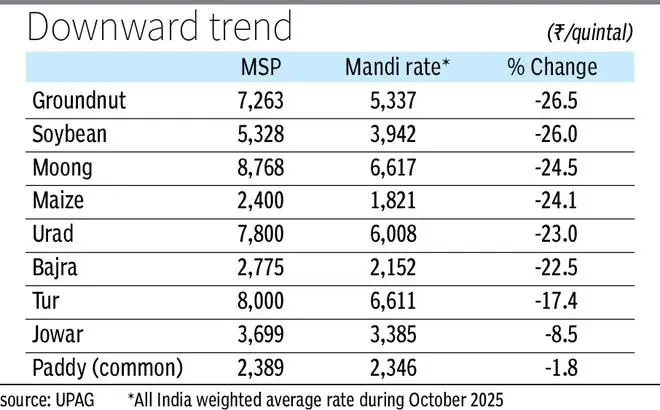Kharif prices crash: Most crops sold below MSP in October amid low state intervention

According to Agriculture Ministry data, the mandi prices of nine major crops – urad (black gram), tur (red gram), moong (green gram), soybean, groundnut, maize, bajra (millet), jowar (sorghum) and paddy – were lower than their respective MSPs in October, and in case of seven crops, the rates were lower by 3-32 per cent compared to October 2024
In a clear sign of rural price distress, nearly all major kharif crops were sold below their minimum support prices (MSPs) in agriculture market yards (mandis) in October, the first month of the kharif harvest season, with only paddy and jowar trading higher than a year ago. Even then, only a small section of paddy farmers who managed to sell to government procurement agencies benefited from the MSP, as market arrivals have seen little state intervention so far this year.
supply side issue
Going forward, the prices of some commodities such as tur may firm up due to supply side issue, provided the government restricts cheaper imports. There is no hope for oilseeds prices to match the MSP levels till December by when farmers almost exhaust their produce, experts said.
According to Agriculture Ministry data, the mandi prices of nine major crops – urad (black gram), tur (red gram), moong (green gram), soybean, groundnut, maize, bajra (millet), jowar (sorghum) and paddy – were lower than their respective MSPs in October, and in case of seven crops, the rates were lower by 3-32 per cent compared to October 2024.
Major Kharif oilseeds, soybean and groundnut were sold about 26 per cent below their MSPs in October, whereas the rates of tur, moong and urad were 17-25 per cent lower than their benchmark rates.

Among the cereals, average maize rates in October were 24 per cent below its MSP of ₹2,400/quintal, and 14 per cent less than the year-ago level. Though the government has been buying ethanol from distilleries at ₹71.86 per litre if made from maize on the basis of its procurement cost calculated at MSP, there is no such statutory obligation for the manufacturers.
Farmers sold bajra at 23 per cent below its MSP of ₹2,775/quintal and jowar at 9 per cent less than ₹3,699/quintal, the data show. However, jowar rate last month was 19 per cent higher from year-ago level, unlike bajra, which was 14 per cent less compared to October 2024.
Paddy is the only crop where the average realisation, as per official data, was 1.8 per cent below MSP, which could be due to a robust procurement system. The government has purchased 46 per cent higher at over 119 lakh tonnes (in terms of rice) until October 31 in current season (October-September).
“Above normal rainfall gave good production. On top of this, there have been good imports of pulses during last two years due to very low duty, resulting supply exceeding demand. As the MSPs are already high, market prices cannot support MSPs unless import duties are hiked,” said Ashok Gulati, a noted economist and former Chairman of Commission for Agricultural Costs and Prices (CACP).
Prices may rise
Commenting on the low pulses prices, Rahul Chauhan of I-Grain said heavy rains in the main producing States have affected both urad and tur crops, and there could be some increase in prices going forward.
“Despite crop damage, prices have not risen as much as expected due to Myanmar’s record production of urad last year and the likelihood of another strong crop this year. But as Myanmar’s new crop will arrive from March 2026, imported urad will continue to fill domestic demand until then, which could support higher prices in the coming months,” said Chauhan.
On tur prices, he added: “Due to heavy rains in Karnataka and Maharashtra, the crop has been affected and it has led to some improvement in domestic prices recently. Going forward, tur prices are expected to rise further.”
The government is yet to release the first advance estimates of production of kharif crops, which is expected next week. Similarly, after approving procurement of some oilseeds and pulses in some States by the Centre, as early as in September, there is no update about actual quantity purchased so far by the government or its agencies.
Published on November 6, 2025



